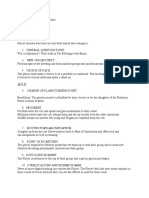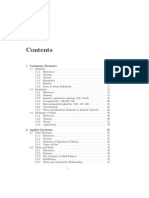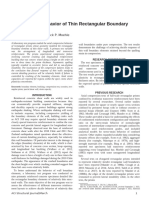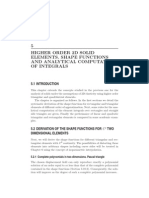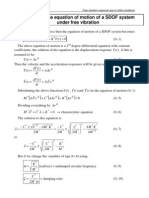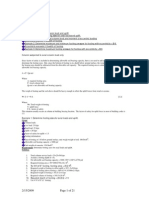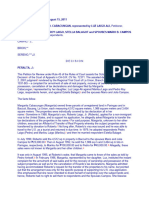Catenary
Catenary
Uploaded by
Mary MarasiganCopyright:
Available Formats
Catenary
Catenary
Uploaded by
Mary MarasiganCopyright
Available Formats
Share this document
Did you find this document useful?
Is this content inappropriate?
Copyright:
Available Formats
Catenary
Catenary
Uploaded by
Mary MarasiganCopyright:
Available Formats
Catenary Curve
Yong-Ming Li
September 3, 2010
1 Designing catenary curve
Based on Webster dictionary, a catenary is the curve assumed by a cord of uniform density and
cross section that is perfectly exible but not capable of being stretched and that hangs freely from
two xed points. In real world, we can nd many examples of catenary as shown in the following
images.
Figure 1: Chains and spider webs
Figure 2: Power lines
1
Y.M. Li 2
Mathematically, a catenary curve is the graph of the hyperbolic cosine function. Through a proper
transformation, the equation of a catenary in Cartesian coordinate has the following standard
simple representation:
y(x) = ucosh
_
x
u
_
=
u
2
_
e
x/u
+ e
x/u
_
,
where cosh is the hyperbolic cosine function. The above function is symmetric to y axis with x = 0
being the lowest point. The larger the u increases, the atter the shape of curve becomes.
In real world application, we need to model a catenary curve with non-symmetric information. For
example, we need to generate a catenary curve that passes through two poles of dierent heights.
For this reason, we represent the catenary curve in the following generic form
[1]
:
y(x) = ucosh
_
x v
u
_
+
where u, v, and are three constants to be determined by the boundary conditions of the problem.
Usually these conditions include two points from which the cable is being suspended and the length
of the cable.
Assume the two points are given by p
1
= (x
1
, y
1
) and p
2
= (x
2
, y
2
). Substituting them into the
above equation we have
y
1
= ucosh
_
x
1
v
u
_
+ (1.1)
y
2
= ucosh
_
x
2
v
u
_
+ (1.2)
In addition to the above two equations, we will need one more equation to form a system of three
equations in three unknowns. We further assume that the cable length L is given. Accordingly,
the third equation would be the arc length of catenary curve, i.e.,
L =
_
x
2
x
1
_
1 + y
(x)
2
dx.
Since
y
(x) = usinh
_
x v
u
__
1
u
_
= sinh
_
x v
u
_
,
we have
L =
_
x
2
x
1
1 + sinh
2
_
x v
u
_
dx =
_
x
2
x
1
cosh
_
x v
u
_
dx
= u
_
x
2
x
1
cosh
_
x v
u
_
d
_
x v
u
_
= usinh
_
x v
u
_
x
2
x
1
= u
_
sinh
_
x
2
v
u
_
sinh
_
x
1
v
u
__
(1.3)
Equations (2.1), (2.2), and (1.3) form a system of nonlinear equations. Solution to the three
unknowns is non-trivial. In this document we illustrate how Newtons method can be used to
Y.M. Li 3
solve the catenary problem. Lets rewrite Equations (2.1), (2.2), and (1.3) in the following forms:
f
1
= ucosh
_
x
1
v
u
_
+ y
1
= 0
f
2
= ucosh
_
x
2
v
u
_
+ y
2
= 0
f
3
= u
_
sinh
_
x
2
v
u
_
sinh
_
x
1
v
u
__
L = 0
It is known that Newtons method requires to compute Jacobian matrix that consists of rst order
partial derivatives. Therefore, we need to compute the following derivatives
f
1
u
= cosh
_
x
1
v
u
_
x
1
v
u
sinh
_
x
1
v
u
_
f
1
v
= sinh
_
x
1
v
u
_
f
1
= 1
f
2
u
= cosh
_
x
2
v
u
_
x
2
v
u
sinh
_
x
2
v
u
_
f
2
v
= sinh
_
x
2
v
u
_
f
3
= 1
f
3
u
= sinh
_
x
2
v
u
_
sinh
_
x
1
v
u
_
1
u
_
(x
2
v) cosh
_
x
2
v
u
_
(x
1
v) cosh
_
x
1
v
u
__
f
3
v
= cosh
_
x
1
v
u
_
cosh
_
x
2
v
u
_
f
3
= 0
Let J denote the Jacobian matrix of the following form
J =
_
_
_
_
_
_
_
f
1
u
f
1
v
f
1
f
2
u
f
2
v
f
2
f
3
u
f
3
v
f
3
_
_
_
_
_
_
_
Then, Newton iteration is done as follows
_
_
u
(k)
v
(k)
(k)
_
_
=
_
_
u
(k1)
v
(k1)
(k1)
_
_
J
1
_
_
f
1
_
u
(k1)
, v
(k1)
_
f
2
_
u
(k1)
, v
(k1)
_
f
3
_
u
(k1)
, v
(k1)
_
_
_
(k = 1, 2, ) (1.4)
where J
1
is the inverse of Jacobian matrix evaluated at (u
(k1)
, v
(k1)
,
(k1)
). We terminate the
iteration when h are smaller than the given distance tolerance. It is readily seen that the lowest
point is given by
P
min
= (v, u + )
Y.M. Li 4
The advantage of Newton method for solving systems of nonlinear equations is its quadratic con-
vergence speed once a sucient accurate approximation is known. A weakness of this method
is that it may diverge when initial poor approximations of u, v, and are given. To overcome
such limitation, the Steepest Descent method may be implemented to nd the good approxima-
tions of u, v, and for Newton iteration method. The Steepest Descent method has only linear
convergence but will usually converge even for poor initial approximations.
Two examples are given here for interested readers:
Example 1 (Symmetric case): With p
1
= (x
1
, y
1
) = (50, 100), p
2
= (x
2
, y
2
) = (50, 100), L =
150, we take u = L/3, v = (x
1
+ x
2
)/2, and = 0.7 min(y
1
, y
2
) as initial approximations and
solve (1.4) for u, v, and . After 7 iteration we obtain u = 39.11697, v = 0.0 and = 15.41196
that guarantee f
1
, f
2
, and f
3
are all less than 1.0e
8
. We can further derive p
min
= (0.0, 54.5289).
Example 2 (Non-symmetric case): With p
1
= (x
1
, y
1
) = (50, 100), p
2
= (x
2
, y
2
) = (60, 120), L =
150, we take again u = L/3, v = (x
1
+ x
2
)/2, and = 0.7 min(y
1
, y
2
) as initial approximations
and solve (1.4) for u, v, and . After 7 iteration we obtain u = 39.72898, v = 0.32893 and
= 24.95907 that guarantee f
1
, f
2
, and f
3
are all less than 1.0e
8
. We can further derive
p
min
= (0.32893, 64.68805).
2 Catenary curve with clearance specied
In the previous section we discussed how to design a catenary curve based given two points and
the cable length. If users input is dierent, one has to derive a new set of equations to solve the
three unknowns that meet the given conditions. For example, cables may drop lower during the
frozen winter as illustrated in the following image. Accordingly, utility workers may want to set
the minimum clearance of power lines for safety reason. Assume we are given coordinates of two
Figure 3: Due to added weight frozen cables are dragged much lower
poles and the lowest clearance height H. In this case, equations Equations (1.1) and (1.2) still hold.
We need to derive the third equation to solve the three unknowns u, v, and . Since the lowest
Y.M. Li 5
point occurs at the end points or a local extrema at which
y
(x) = usinh
_
x v
u
__
1
u
_
= sinh
_
x v
u
_
= 0.
This in turn means that
x v
u
= 0, x = v.
Accordingly, we have
y(x) = ucosh
_
x v
u
_
+
x=v
= H = u + .
Replacing = H u in equations (1.1) and (1.2) we obtain two equations for two unknowns:
y
1
= ucosh
_
x
1
v
u
_
+ H u (2.1)
y
2
= ucosh
_
x
2
v
u
_
+ H u (2.2)
Let
f(u, v) = ucosh
_
x
1
v
u
_
+ H y
1
u = 0
g(u, v) = ucosh
_
x
2
v
u
_
+ H y
2
u = 0
Dierentiating f and g with respect to u and v gives
f
u
= cosh
_
x
1
v
u
_
x
1
v
u
sinh
_
x
1
v
u
_
1
f
v
= sinh
_
x
1
v
u
_
g
u
= cosh
_
x
2
v
u
_
x
2
v
u
sinh
_
x
2
v
u
_
1
g
v
= sinh
_
x
2
v
u
_
Accordingly, we can use equation (1.4) to solve u and v, noting that the third unknown is given
by = H u.
3 Catenary curve with sag specied
Some applications require to restrict the sag at the middle between two poles as shown below.
With the sag value being known, we have
y
1
+ y
2
2S
2
= ucosh
_
x
1
+ x
2
2v
2u
_
+ . (3.1)
Subtracting equation (1.2) from (1.1) gives f(u, v) and subtracting equation (3.1) from (1.1) gives
g(u, v) as follows:
f(u, v) = cosh
_
x
2
v
u
_
cosh
_
x
1
v
u
_
y
2
y
1
u
= 0
g(u, v) = cosh
_
x
1
v
u
_
cosh
_
x
1
+ x
2
2v
2u
_
y
1
y
2
+ 2S
2u
= 0
Y.M. Li 6
Figure 4: Sag value at middle is known
Dierentiating f and g with respect to u and v gives
f
u
=
1
u
2
_
sinh
_
x
2
v
u
_
(x
2
v) sinh
_
x
1
v
u
_
(x
1
v) (y
2
y
1
)
_
f
v
=
1
u
_
sinh
_
x
2
v
u
_
sinh
_
x
1
v
u
__
g
u
=
1
u
2
_
sinh
_
x
1
v
u
_
(x
1
v) sinh
_
x
1
+ x
2
2v
2u
__
x
1
+ x
2
2v
2
_
_
y
1
y
2
+ 2S
2
__
g
v
=
1
u
_
sinh
_
x
1
+ x
2
2v
2u
_
sinh
_
x
1
v
u
__
Accordingly, we can use equation (1.4) to solve u and v, noting that the third unknown can be
solved using equation (1.1).
4 Representation of catenaries in CAD system
In most CAD systems, B-spline curves and surfaces are the de facto standard for modeling and
representing complex shapes that cannot be described by line and arc. Since a B-spline curve is a
piecewise rational curve, approximation is needed when it is used to represent a non-rational curve
such as a catenary. In this section we discuss how to create a B-spline curve that approximates a
given catenary curve within any given tolerance.
Both hyperbolic sine and cosine have the following convergent Taylor series (or Maclaurin series)
for all real values of x.
sinh x = x +
x
3
3!
+
x
5
5!
+ =
n=0
x
2n+1
(2n + 1)!
(4.1)
cosh x = 1 +
x
2
2!
+
x
4
4!
+ =
n=0
x
2n
(2n)!
(4.2)
An innite series cannot be represented in a computer. It has to be truncated and represented as
a polynomial. Accordingly, the truncated polynomial curve can be represented as a B-spline curve
in CAD systems. Before doing so, however, we need to consider the following two aspects:
Y.M. Li 7
Does the series converge to its analytic function uniformly? By observation it is readily seen
that it converges faster when x is at the neighborhood of 0 and slower when x is large. This
in turn means that we would need a lower degree polynomial for x near 0 and higher degree
polynomial when x is away from 0, which is impractical.
Does the truncated polynomial have the best approximation to its analytic function?
These two obstacles lead us to look for the Legendre series which, by the following theorem, has a
promising property in approximation theory.
Theorem 4.1 Let E
be an ellipse on the complex plane with the center at (0, 0), the major semi-
axis, a = ( + 1/)/2, on the axis of real numbers, and the minor semi-axis, b = ( 1/)/2, on
the axis of imaginary numbers. Let f(z) be analytic in the interior of E
with > 1, but not in
the interior of any E
with
> . Then,
f(z) =
k=0
a
k
l
k
(z)
where l
k
(z) are Legendre polynomials of degree k and
a
k
=
2k + 1
2
_
+1
1
l
k
(x)f(x)dx
That is to say there exists a Legendre series converging absolutely and uniformly to f(z) on any
closed set in the interior of E
. Moreover,
lim
k
sup|a
k
|
1/k
=
1
.
Proof of the above theorem may be found in
[3]
and the computation of a
k
can be found in
[4],[5]
.
In real analysis, we are concerned with analytic functions f on a real interval [1, 1] (If f is dened
in an arbitrary interval [a, b], we can reparametrize f(x) by t = (2x b a)/(b a) such that
t [1, 1]). Then, by the Neumann theorem, there exists a Legendre series converging absolutely
and uniformly to f on [1, 1]. Further, the converging speed is determined by . Therefore,
problems with respect to the use of a Taylor series are avoided if a Legendre series is used.
Since the Legendre series converges absolutely and uniformly to f(x) on [1, 1]. Therefore, given
an arbitrarily small number > 0, there exists M such that when m > M we have
f(x)
m
k=0
a
k
l
k
(x)
< .
Accordingly, we can use the truncated Legendre series to approximate f(x). It is only a matter of
polynomial basis conversion to convert the truncated Legendre series to the B-spline form
[6]
.
References
[1] http://en.wikipedia.org/wiki/Catenary
Y.M. Li 8
[2] Abramowitz, M. and Stegun, I. (1972), Handbook of Mathematical Functions, Dover Pub.,
Inc.
[3] Davis, P.J. (1975), Interpolation & Approximation, Dover Pub., Inc.
[4] Li, Y.M. and Hsu, V.Y., Curve osetting based on Legendre series, Computer Aided Geometric
Design 15 (1998), 711-720.
[5] Malosse, J-J (1994), Parametrisation of implicit elliptic curves by rational functions, in R.B.
Fisher ed. Design and Application of Curves and Surfaces: The Mathematics of Surfaces V,
Oxford Univ. Press.
[6] Li, Y.M. et al, Basis conversion among Bezier, Tchebyshev, and Legendre, Computer Aided
Geometric Design 15 (1998), 631-636.
You might also like
- CCNAv7 Product OverviewDocument31 pagesCCNAv7 Product Overviewnetgame76100% (1)
- Subject: It Capstone Project: University of Education Lahore, D.G.Khan CampusDocument18 pagesSubject: It Capstone Project: University of Education Lahore, D.G.Khan CampusIT LAb 2No ratings yet
- Notes On The Linear Analysis of Thin-Walled BeamsDocument76 pagesNotes On The Linear Analysis of Thin-Walled BeamsPasc Oana JianinaNo ratings yet
- Catenary CablesDocument110 pagesCatenary CablesErnie Ernie100% (1)
- Homework 2Document7 pagesHomework 2Chinny LyheangNo ratings yet
- GMK5225 Product GuideDocument28 pagesGMK5225 Product GuideMary MarasiganNo ratings yet
- Session 5-3: Thailand Case Study by Kraiyos PatrawartDocument30 pagesSession 5-3: Thailand Case Study by Kraiyos PatrawartADBI Events100% (1)
- PlotDocument2 pagesPlotAlex GregorieNo ratings yet
- BÀI KT 2 K NĂNG T NG H P 4 B2-PhúcDocument4 pagesBÀI KT 2 K NĂNG T NG H P 4 B2-PhúcMy Tien Tran67% (3)
- Kasaysayan 1 - UP DilimanDocument9 pagesKasaysayan 1 - UP Dilimandepachie100% (2)
- Continuum MechanicsDocument120 pagesContinuum Mechanicsxsaraneel2474No ratings yet
- St. Venant's Torsional TheoryDocument12 pagesSt. Venant's Torsional TheoryAJA14No ratings yet
- 5.-Three-Moment-Equation by Sir Vuangh BarrientosDocument10 pages5.-Three-Moment-Equation by Sir Vuangh BarrientosejlNo ratings yet
- Moment Distribution Method PPTXDocument45 pagesMoment Distribution Method PPTXMira RuthNo ratings yet
- NCCI: Design Model For Simple Column Bases-Axially Loaded I Section ColumnsDocument17 pagesNCCI: Design Model For Simple Column Bases-Axially Loaded I Section ColumnsaliomairNo ratings yet
- Finite Element MethodsDocument12 pagesFinite Element Methodspraneeth4a100% (1)
- Theory of Elasticity Supplementary Notes: J. N. ReddyDocument52 pagesTheory of Elasticity Supplementary Notes: J. N. ReddykkhemmoNo ratings yet
- Conjugate Beam METHODDocument13 pagesConjugate Beam METHODAdam Ahmed100% (1)
- Prestressed Concrete Analysis and Design Fundamentals 2nd Ed CAP 4 PDFDocument76 pagesPrestressed Concrete Analysis and Design Fundamentals 2nd Ed CAP 4 PDFCarlos Alberto Pacheco SierraNo ratings yet
- Som Ks YadavDocument473 pagesSom Ks Yadavdivyanshshrivastava9321No ratings yet
- Note 5Document14 pagesNote 5MohamedNo ratings yet
- Application of Fourier Series in Beam-Column Problems: Basic Equation For The Elastic Beam-Column IsDocument3 pagesApplication of Fourier Series in Beam-Column Problems: Basic Equation For The Elastic Beam-Column IsadanNo ratings yet
- Finite Strain TheoryDocument19 pagesFinite Strain TheorySnehasish BhattacharjeeNo ratings yet
- Forces and Moments Transmitted by Slender Members: 446.201A (Solid Mechanics) Professor Youn, Byeng DongDocument15 pagesForces and Moments Transmitted by Slender Members: 446.201A (Solid Mechanics) Professor Youn, Byeng DongDon eladioNo ratings yet
- FEM For Heat Transfer Problems (Finite Element Method) Part 3Document16 pagesFEM For Heat Transfer Problems (Finite Element Method) Part 3Sibilla UnniNo ratings yet
- Dynamicass 1Document2 pagesDynamicass 1Phanendra Kumar AttadaNo ratings yet
- Stability & Buckling Module 9Document10 pagesStability & Buckling Module 9maran.suguNo ratings yet
- Karthik Mander 2010Document4 pagesKarthik Mander 2010Electronic RaccoonNo ratings yet
- Comparative Analysis of The Buckling FacDocument6 pagesComparative Analysis of The Buckling FacFernanda JaramilloNo ratings yet
- Second Order Analysis of StructuresDocument10 pagesSecond Order Analysis of Structuresanimesh91No ratings yet
- 2.3 - Stress Strain RelationsDocument12 pages2.3 - Stress Strain RelationscastorNo ratings yet
- 14.beam Analysis Using The Stiffness Method PDFDocument23 pages14.beam Analysis Using The Stiffness Method PDFjacksonNo ratings yet
- StodolaDocument3 pagesStodolaGlenda HernandezNo ratings yet
- Tveit1987-Consideraciones de Diseño de NetworkDocument19 pagesTveit1987-Consideraciones de Diseño de NetworkErnesto Fidel Mandujano CardenasNo ratings yet
- Galerkin MethodsDocument7 pagesGalerkin MethodsM sNo ratings yet
- S TN RCS 001 PDFDocument10 pagesS TN RCS 001 PDFRaul Bedoya HerediaNo ratings yet
- IIT Guhati Note Continuum MechanicsDocument254 pagesIIT Guhati Note Continuum MechanicsRahul KarnaNo ratings yet
- Static Analysis of Cable-Stayed BridgesDocument14 pagesStatic Analysis of Cable-Stayed BridgesDam HoangNo ratings yet
- Finite Elements For Plates and ShellsDocument79 pagesFinite Elements For Plates and ShellsManish ShrikhandeNo ratings yet
- Torsion Including Warping of Open SectionsDocument6 pagesTorsion Including Warping of Open SectionsahmedanyNo ratings yet
- Mario Paz & William Leigh - Integrated Matrix Analysis of StructuralDocument334 pagesMario Paz & William Leigh - Integrated Matrix Analysis of Structuralkevin arnoldNo ratings yet
- Nonlinear Analysis of Membrane Elements by Fixed-Angle Softened-Truss ModelDocument9 pagesNonlinear Analysis of Membrane Elements by Fixed-Angle Softened-Truss ModelpicottNo ratings yet
- Chapter 5: TorsionDocument106 pagesChapter 5: Torsionprabin gautamNo ratings yet
- 7 - Course - in - Plastic - Limit - Analysis - Univ - Delft - Prof Vrouwenvelder-Beams-Frames PDFDocument121 pages7 - Course - in - Plastic - Limit - Analysis - Univ - Delft - Prof Vrouwenvelder-Beams-Frames PDFAnonymous Z1TsfwFx9mNo ratings yet
- The Effect of Shear Deformations On The Elastic Critical Column LoadDocument5 pagesThe Effect of Shear Deformations On The Elastic Critical Column Loadashok paul100% (2)
- Linear Time Triangulation of Special Polygons: Deepit Purkayastha 09CS3013Document8 pagesLinear Time Triangulation of Special Polygons: Deepit Purkayastha 09CS3013Deepit PurkayasthaNo ratings yet
- PapeerDocument23 pagesPapeerEMANUEL 07No ratings yet
- Continuum Mechanics For EngineersDocument448 pagesContinuum Mechanics For EngineersAhmadreza AminianNo ratings yet
- Higher Order 2D Solid Elements. Shape Functions andDocument29 pagesHigher Order 2D Solid Elements. Shape Functions andJose2806No ratings yet
- Concreto Pre Tensado en Sap2000Document15 pagesConcreto Pre Tensado en Sap2000Tre0No ratings yet
- CM Exam 2015dec21Document9 pagesCM Exam 2015dec21sepehrNo ratings yet
- L12 - Plastic Analysis PDFDocument9 pagesL12 - Plastic Analysis PDFSunil Kumar P GNo ratings yet
- Timoshenko BeamsDocument3 pagesTimoshenko BeamstimsykiNo ratings yet
- Differential Geometry:: Delaunay Triangulations and The Laplace-Beltrami OperatorDocument56 pagesDifferential Geometry:: Delaunay Triangulations and The Laplace-Beltrami OperatorTrần HươngNo ratings yet
- Advanced Mechanics of MaterialsDocument2 pagesAdvanced Mechanics of MaterialsShubham BhagwatNo ratings yet
- Structural Analysis Lesson PlanDocument1 pageStructural Analysis Lesson PlanRamesh AdhikariNo ratings yet
- 4.SDOF Systems in Free VibrationDocument5 pages4.SDOF Systems in Free VibrationshamshiriNo ratings yet
- ST7201-Finite Element MethodDocument14 pagesST7201-Finite Element MethodVishal RanganathanNo ratings yet
- Introduction To Seismic Essentials in GroningenDocument14 pagesIntroduction To Seismic Essentials in GroningenKay Chan SothearaNo ratings yet
- Truss 3d ExampleDocument16 pagesTruss 3d ExampleangegkarNo ratings yet
- Fast and Secure Elliptic Curve Scalar Multiplication Over Prime Fields Using Special Addition ChainsDocument14 pagesFast and Secure Elliptic Curve Scalar Multiplication Over Prime Fields Using Special Addition ChainsTall AmadouNo ratings yet
- Nonreflecting Boundary Conditions For Euler Equations in Generalized Curvilinear CoordinatesDocument44 pagesNonreflecting Boundary Conditions For Euler Equations in Generalized Curvilinear CoordinatesadriansescuNo ratings yet
- Chapter 3Document25 pagesChapter 3Rohit GadekarNo ratings yet
- Solving Poisson's Equation by Finite DifferencesDocument6 pagesSolving Poisson's Equation by Finite DifferencesEugene LiNo ratings yet
- 2024-02-20 MA110 Slides CompilationDocument62 pages2024-02-20 MA110 Slides CompilationmayankspareNo ratings yet
- COHEN - Mixed Finite Elements With Mass-Lumping For The Transient Wave EquationDocument18 pagesCOHEN - Mixed Finite Elements With Mass-Lumping For The Transient Wave EquationAndrés MercadoNo ratings yet
- Student Solutions Manual to Accompany Economic Dynamics in Discrete Time, second editionFrom EverandStudent Solutions Manual to Accompany Economic Dynamics in Discrete Time, second editionRating: 4.5 out of 5 stars4.5/5 (2)
- Drawing Setup LTDocument17 pagesDrawing Setup LTMary MarasiganNo ratings yet
- Canopy A - ResultDocument21 pagesCanopy A - ResultMary MarasiganNo ratings yet
- CAD Sizing ChartDocument1 pageCAD Sizing ChartEdupuganti Sujith KumarNo ratings yet
- Bolts,: Threaded Parts TensionDocument2 pagesBolts,: Threaded Parts TensionMary Marasigan100% (1)
- Let There Be PeaceDocument3 pagesLet There Be PeaceMary MarasiganNo ratings yet
- ,,,Document30 pages,,,Ilmi FeratiNo ratings yet
- Spread FootingDocument15 pagesSpread FootingMary MarasiganNo ratings yet
- IMDocument9 pagesIMvishal sharmaNo ratings yet
- Analytical Methods For Determination of Benzodiazepines. A Short ReviewDocument14 pagesAnalytical Methods For Determination of Benzodiazepines. A Short ReviewKarla Labbe Rodriguez100% (1)
- Faster Than A Speeding Bullet A Freshman Kinetics ExperimenDocument2 pagesFaster Than A Speeding Bullet A Freshman Kinetics ExperimenAbel de Jesús RiveraNo ratings yet
- EXAM Timetable - 22 July 2015Document3 pagesEXAM Timetable - 22 July 2015Qawi RosleeNo ratings yet
- Euphoria Special Edition Rue ScriptDocument24 pagesEuphoria Special Edition Rue ScriptMoldovan EdithNo ratings yet
- Sasha and The Pearl Drama ScriptDocument9 pagesSasha and The Pearl Drama ScriptAndi DermawanNo ratings yet
- Review Notes in Ballistics 2 1Document8 pagesReview Notes in Ballistics 2 1Sherwin Bryan Malabanan100% (1)
- GE CaseDocument20 pagesGE CaseMeenal MalhotraNo ratings yet
- Cause and Effect Essay OutlineDocument2 pagesCause and Effect Essay Outlineapi-311895652No ratings yet
- A Review by MalathiDocument12 pagesA Review by MalathiSudheer Kumar NadukuditiNo ratings yet
- Practice Questions - Cash FlowDocument13 pagesPractice Questions - Cash FlowMariamNo ratings yet
- Sustainable Planning & Architecture: Notes Prepared by Ar. Achilles Sophia M.GDocument33 pagesSustainable Planning & Architecture: Notes Prepared by Ar. Achilles Sophia M.GVijay VNo ratings yet
- Lat English GrammarDocument32 pagesLat English Grammarmuhammadaslam595631No ratings yet
- Electrical Engineering Portal - Com Demand Factor Diversity Factor Utilization Factor Load FactorDocument12 pagesElectrical Engineering Portal - Com Demand Factor Diversity Factor Utilization Factor Load FactorBijay AgrawalNo ratings yet
- Fernandez Vs CADocument6 pagesFernandez Vs CAMaricel Caranto FriasNo ratings yet
- Penny ArcadeDocument1 pagePenny ArcadeAlejandra PomboSuNo ratings yet
- Jack Greenberg Audit CaseDocument4 pagesJack Greenberg Audit CaseArianna Maouna Serneo Bernardo50% (2)
- Discuss W.B Yeats Treatment of Myth and HistoryDocument2 pagesDiscuss W.B Yeats Treatment of Myth and HistorySawera AbdullahNo ratings yet
- Full Step To Sideload TVMC (XBMC) To Amazon FireTV StickDocument19 pagesFull Step To Sideload TVMC (XBMC) To Amazon FireTV Stickkhkiran100% (1)
- RfedtghyjDocument108 pagesRfedtghyjDomenico Pestilli80% (5)
- KMC - GEC Semester I (2023-24) - Final List : Botany: Protected Agriculture - Hydroponics and Organic CultivationDocument135 pagesKMC - GEC Semester I (2023-24) - Final List : Botany: Protected Agriculture - Hydroponics and Organic CultivationdhingrakajitNo ratings yet
- G.R. No. 175073 August 15, 2011Document9 pagesG.R. No. 175073 August 15, 2011Kharol EdeaNo ratings yet
- Interviews Everett ChandlerDocument6 pagesInterviews Everett Chandlerapi-207736114No ratings yet
- Thermal Conductivity of Refractory Brick PDFDocument7 pagesThermal Conductivity of Refractory Brick PDFFerNo ratings yet







